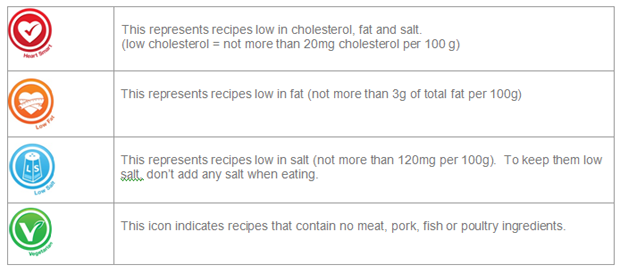We have introduced a new feature in our recipe section, to identify whether a recipe is low fat, ‘heart smart’, low salt or vegetarian using the following symbols.

In addition to these icons, we have also included a nutrition table on the recipes page.
How to make sense of Nutritional information tables:
Example of a nutritional table:
|
Typical Nutritional Information (ready-to-eat) |
Per 100g |
Per Serving (335g) |
|
Energy (kJ) |
238 |
797.3 |
|
Total protein (g) |
4.8 |
16 |
|
Carbohydrate (g) |
6.6 |
22.1 |
|
Total fat (g) |
0.6 |
2 |
|
of which: Saturated fat (g) |
0.09 |
0.3 |
|
Trans fat (g) |
0 |
0 |
|
Mono-unsaturated fat (g) |
0.19 |
0.64 |
|
Polyunsaturated fat (g) |
0.11 |
0.37 |
|
Cholesterol (mg) |
12 |
40.2 |
|
Dietary fibre (g) |
1.3 |
4.4 |
|
Total sodium (mg) |
96 |
321.6 |
|
Units of measurements of Nutrients |
|
kJ |
Kilojoule |
|
g |
Gram |
|
mg |
Milligram |
|
mcg |
Microgram |
The nutritional information provided in a table are values that are calculated for the final product, i.e.: a cooked recipe. On the table it states the nutritional information for either a ready-to-eat product or a product that requires additional preparation prior to eating, because this would then affect the final nutrient values.
Nutritional values are provided per 100g so that information of different products can be easily compared. Remember that the nutrient values for 100g are not necessarily going to be the amount that you will consume – note the ‘per serving’ value. These values have been calculated for the typical serving size that will be eaten.
What is the kJ value?
A kJ (Kilojoule) is the unit value of the energy derived from food. This energy can come from fat or carbohydrates or protein, the energy value provided is measured in Kilojoules. Internationally, the energy value is represented in the Kilocalorie unit and it is important to understand that these are not the same:
1 Kilocalorie = approximately 4.2 Kilojoules.
If one consumes too many kJ’s on a daily basis, one will gain weight.
What is Protein?
Protein forms the ‘building blocks’ of muscle, organs, hair and nails. Protein is made up of different amino acids. Eating foods high in protein will assist in maintaining our muscles, organs, hair and nails.
There are two different sources of protein:
-
Animal (beef, pork, poultry, fish, eggs and dairy)
-
Plant (nuts, seeds, beans and legumes)
What is a Carbohydrate?
Carbohydrates (CHO’s) from food provide us with energy and fibre or roughage. They are made up of different sugars, starches and cellulose. They can be ‘simple’ e.g. sugars/honey or ‘complex’ e.g. wheat. CHOS’s high in fibre or roughage help our digestive systems to function efficiently. CHO’s are not sources of fat and shouldn’t be completely omitted from your diet.
What is Total fat?
Dietary fat also provides us with energy. Each gram of fat provides us with double the energy that CHO’s do and we therefore need very little from our diet if we are only moderately active.
1 g fat provides 38 Kilojoules of energy vs 1 g CHO providing 17 Kilojoules of energy.
There are the following different types of fat:
Saturated Fat is considered to be one of the unhealthier fats however it is still vital. This being said, our bodies do synthesize its own saturated fat so minimal consumption is required. Saturated fats can be identified as hard fats (butter, visible fat/marbling on meat).
Trans Fat is largely a fat introduced by processing - the process of hydrogenation transforms natural unsaturated oils into solid form (hard margarine). This fat can increase ‘bad cholesterol’ levels and has been linked to heart disease, so should therefore be avoided as much as possible.
Unsaturated Fats are considered to be the ‘good fats’ as they help maintain lower cholesterol levels. Unsaturated fats can be found as:
-
Mono-unsaturated fats which are not essential for the body but are still healthier than saturated fats. Examples of these fats are canola, olive, peanut and avocado oils.
-
Poly-unsaturated fats are essential for the body. It is used for the creation of hormones and cell wall structure. Examples of these fats are sunflower, safflower oils and fish oils.
What is Cholesterol?
This substance is found naturally in our blood and is produced by the liver. Our bodies need cholesterol to assist in the production of new cells. High-Density-Lipoprotein (HDL) is considered to be the ‘good cholesterol’ as this cholesterol travels to the liver where it is broken down. Low-Density-Lipoprotein (LDL) is considered to be the ‘bad cholesterol’ as this is transported away from the liver and into the blood vessels, and can block blood vessels e.g. in the case of heart disease.
What is Dietary Fibre?
This is also commonly known as roughage and assists in keeping your bowel regular. Fibre is important as it acts as natural ‘detergent’, cleansing out intestines. It also helps to lower cholesterol levels and reduce the risk of diabetes and heart disease. Fibre is found in fruit and vegetables and non-refined cereal products such as bran, oats and whole wheat flour.
What is Sodium?
Sodium, commonly referred to as salt, is a mineral that should be used sparingly. It is commonly added to instant soups, braai spice, cured and processed meats and snack foods. Sodium increases blood pressure and is linked to heart disease. Using low sodium salt or natural flavourings such as fresh herbs or curry powder, is a better option.
Vitamins and Minerals
When a claim is made about a product e.g. high in Vitamin C, the nutritional table will have to state the amount of vitamin or mineral in the product. This is usually measured in mcg’s.